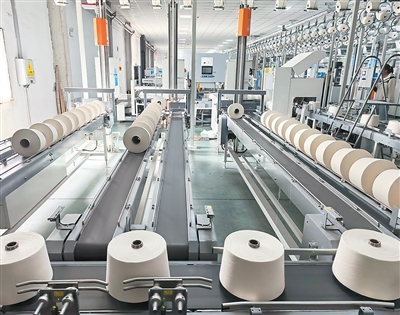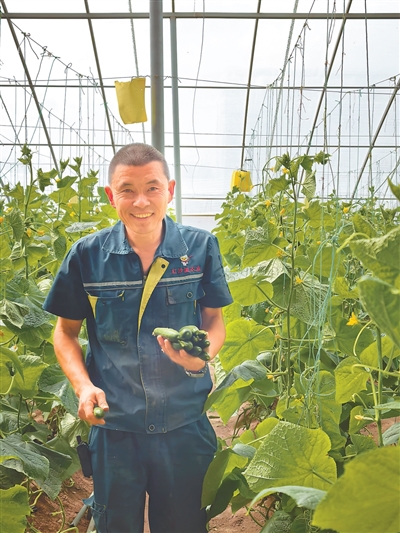




- BRNN
- BRI News
- BRNN News
- Database
Official Documents Polices and Regulations
Inter-government Documents International Cooperation BRI Countries
Business Guide Economic Data BRI Data
Trade
Investment Projects Latest projects
Cases - Content Pool
Characteristic industries have brought tangible benefits to residents in Aksu Prefecture, northwest China's Xinjiang Uygur Autonomous Region.
Ailinuer Agricultural Technology Development Co., Ltd. in Keping county, Aksu, has grown into a nationally recognized leading enterprise in agricultural industrialization.
The company's flour mill operates with a high degree of automation, with more than a dozen machines running continuously in sequence.

Photo shows the workshop of a flour mill of Ailinuer Agricultural Technology Development Co., Ltd. in Keping county, Aksu Prefecture, northwest China's Xinjiang Uygur Autonomous Region. (People's Daily Overseas Edition/Yu Shangbo)
At the company's industrial park for nang, a type of flatbread typical of the region, individually packaged products—including camel milk nang, rose jam nang, walnut nang, and black rye nang—are being produced at full capacity, with distribution networks extending throughout and beyond Xinjiang. The company has also developed high-value-added products such as freeze-dried powder and raw juice made from turnip, a distinctive local crop.
Kedirye Nemet, a resident of the nearby Gaizilike town, graduated from Xinjiang Agricultural University and joined the company in April this year. "There are quite a few local university graduates at the company. The atmosphere is great, and my colleagues are like family. I'm now involved in the research and development of turnip products, and I plan to build my career here for the long term," Kedirye Nemet said.
In Awati county, cotton harvesters roar across the fields. With just one driver and one worker, each harvester can complete the harvesting of 200 mu (about 13.33 hectares) of cotton daily. The premium long-staple cotton is then transported to textile mills.

Photo shows a workshop of Awati Lihua Textile Co., Ltd. in Awati county, Aksu Prefecture, northwest China's Xinjiang Uygur Autonomous Region. (People's Daily Overseas Edition/Yu Shangbo)
Inside the digitalized workshop of Awati Lihua Textile Co., Ltd. in the county, every stage of traditional cotton textile production is now managed mainly by modern equipment.
Heading west from Aksu city toward Keping county, endless stretches of Gobi Desert flank the road, and a massive, newly built agricultural exhibition hall gradually comes into view.
Wang Konghui, from Shouguang city in east China's Shandong Province, heads a facility agriculture company spanning 1,500 mu and featuring over 200 modern solar greenhouses in Keping county.

Wang Konghui, head of a facility agriculture company, shows cucumbers in a greenhouse in Keping county, Aksu Prefecture, northwest China's Xinjiang Uygur Autonomous Region. (People's Daily Overseas Edition/Yu Shangbo)
In 2021, attracted by the county's investment promotion policies, he began construction with support from government funding. Following the principle of preserving existing arable land, he transformed parts of the Gobi Desert and adopted a sand-soil cultivation model for planting.
Inside the vegetable greenhouses, seasonal crops such as tomatoes, cowpeas, and cucumbers are thriving. Southern crops have also found a home in the climate-controlled facilities, where tropical fruits like mangoes, pineapples, and dragon fruit, as well as Anji white tea and Longjing tea trees flourish.
With technical support from Xinjiang Agricultural University, Wang also operates a substantial aquaculture business. More than 300,000 freshwater prawns and over 400 kilograms of crab seedlings are raised in 24 circular and 20 rectangular pools, with products already entering the market.
"The development of facility agriculture in the Gobi Desert wouldn't have been possible without strong government support in both funding and personnel," Wang said, adding that the company plans to build its fourth-phase facilities, develop more premium products, and begin exporting to Central Asia in 2026.
Over 160 residents from nearby villages have found stable employment at Wang's facilities.
The Wanfeng Camel Breeding Base in Keping county serves as both a modern camel breeding facility and a national 3A-level tourist attraction.
Previously, the county had around 8,000 camels, primarily raised by individual households through traditional methods. The turning point came in 2021, when the county decided to have state-owned livestock companies take the lead in demonstrating large-scale breeding.

Photo shows camels at the Wanfeng Camel Breeding Base in Keping county, Aksu Prefecture, northwest China's Xinjiang Uygur Autonomous Region. (People's Daily Overseas Edition/Yu Shangbo)
Keping county now maintains a camel population of 56,000, ranking first among all counties in Xinjiang. Annual camel milk production in the county has reached 7,500 tonnes, with more than 30 camel-derived products developed. Combined with tourism revenue generated by the camel herds, the entire camel industry chain now generates a value of 2 billion yuan (about $281.72 million).
The county has introduced a comprehensive package of support policies covering infrastructure development, breeding stock introduction, scientific research investment, and brand building. Farmers who purchase qualified breeding male camels receive subsidies ranging from 3,000 to 5,000 yuan per head, while those constructing standardized pens are rewarded through a "build first, subsidize later" mechanism.
Statistics show that the camel industry chain in Keping county has created over 1,000 jobs for local residents, increasing average household income by 50,000 yuan.

Tel:86-10-65363107, 86-10-65368220, 86-10-65363106